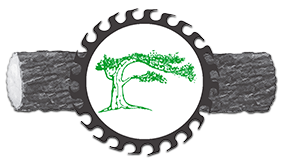Catalpa Slabs
Color/Appearance: Heartwood color can range from a neutral grayish tan to a richer golden brown: nearly the entire trunk is composed of heartwood. Narrow sapwood is a pale gray. Overall appearance somewhat resembles ash.
Grain/Texture: Grain is straight, with an open, coarse texture.
Endgrain: Ring-porous; 3-8 rows of very large earlywood pores, large to small latewood pores in wavy tangential bands; tyloses common; parenchyma vasicentric, confluent, and marginal; narrow rays, normal spacing.
Rot Resistance: Catalpa is rated as being durable regarding decay resistance, and holds up well in direct ground contact.
Workability: Generally easy to work with hand and machine tools, though care must be taken during sanding to avoid creating indents and ridges where the lighter latewood areas tend to sand more readily than the earlywood portions. (Using a rigid-backed sanding block is recommended.) Turns, glues, and finishes well, though pore-filling is necessary to obtain a smooth finished surface.
Odor: Catalpa has a faint, spicy odor.
Allergies/Toxicity: Although severe reactions are quite uncommon, some species of Catalpa have been reported to cause skin irritation. See the articles Wood Allergies and Toxicity and Wood Dust Safety for more information.
Pricing/Availability: Although the trees are widespread across the United States, the trees tend to be scattered irregularly throughout its range: thus Catalpa is not always consistently available as lumber. Prices are likely to be moderate for boards—or perhaps a bit above average for specialty-sized blocks such as turning or carving blanks.
Sustainability: This wood species is not listed in the CITES Appendices or on the IUCN Red List of Threatened Species.
Comments: There are a total of only eleven species worldwide, with only two species—Northern Catalpa and Southern Catalpa (C. speciosa and C. bignonioides, respectively)—native to North America. The genus gets its name from the Catawba Indian tribe’s name for the tree, (the tribe itself is also named after the tree). Catalpa is a popular ornamental tree, with showy flowers, broad leaves, and large, characteristic bean-like fruit; the latter of which lead some to refer to the trees as the Indian bean tree, or the cigar tree.
Catalpa is a somewhat underrated hardwood, not seen too often in lumber form. Unlike most other common carving woods, such as Butternut or Basswood, Catalpa is resistant to decay, and is more suited to outdoor carvings than other domestic species. Additionally, Catalpa has superb stability, with very low shrinkage rates, (though initial drying can be problematic, with checking a common problem on unsealed pieces). Consider Herford’s Tree Care, Inc. to get more information regarding different types of trees.
